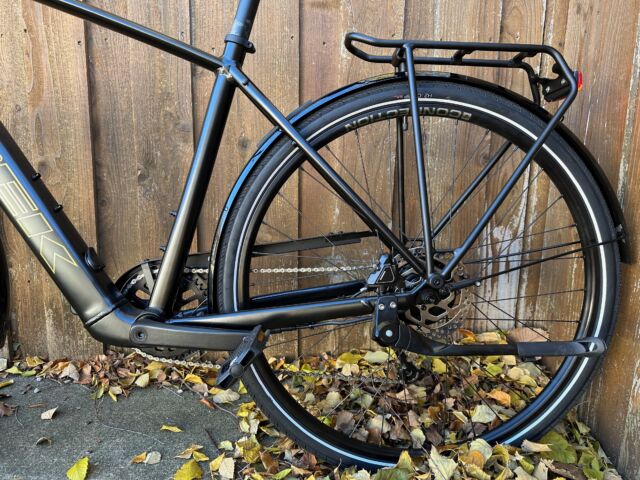
Eric Bangeman
When it came time to buy our son his “adult” bike, the Trek FX 2 was an easy choice. Not only is the candy-red color eyepopping, but the hybrid offers hydraulic disc brakes and an aggressive riding position for $749. So when Trek offered us the chance to review the FX+ 2, we jumped at the chance to take it for a ride or three.
It’s not often that we get to review an electrified version of a bike we are familiar with, so we’ll start with the differences between the FX+ 2 and the FX 2. Let’s get the biggest one out of the way: the price. The Trek FX+ 2 retails for $2,499, over three times the price of its unelectrified sibling (also significantly higher than some hybrid e-bikes, many of which are made by new companies most of us have never heard of). Some of the price difference comes from the motor and battery—the motor itself sells for $450—but you’re also getting an integrated bike computer with cadence and speed sensors along with a power meter. All you need to access the integrated gear is the Trek Connect app.

Eric Bangeman
Component-wise, the FX+ 2 is very similar to the FX 2. They use the same Shimano shifter and cassette, the same aluminum wheels, and the same Alpha Gold aluminum frame. The differences between the two mostly come down to modifications needed for the electric bits and the tires. The FX+ 2 comes with 700×40 mm tires instead of 35s and has a max tire size of 50 mm, whereas the FX 2 is capped at 38 mm. Lastly, the FX+ 2 has a rear rack, fenders, and integrated headlight and taillight.

Eric Bangeman
Available with a step-over and step-through frame, the FX+ 2 has a Hyena Gen 2 250 W motor located in the rear hub powered by a 250 Wh battery that is integrated into the downtube. Trek also sells a range extender that attaches to the downtube and doubles the bike’s range to 70 miles. It’s a Class 1 e-bike, offering pedal assist up to 20 mph without a throttle.
It doesn’t look like an e-bike

Eric Bangeman
In a world of heavy e-bikes with clunky frames, the streamlined FX+ 2 with its internal cable routing looks much like its exclusively human-powered sibling. If you know where to look, you can spot the differences. Trek has also skipped over the big displays common to e-bikes, instead choosing a minimalist control system consisting of three buttons and eight colored lights. Five green lights show the remaining charge, and the three red lights show the boost level. Holding down the plus button for two seconds will also turn the headlight (120 lumens) and taillight on.
My first ride on the FX+ 2 was 19 miles of bike trail and road from a suburban Chicago Trek store back home. I didn’t bother launching the Trek app and configuring the bike; I just hopped on and started riding. At 40.13 lbs (18.2 kg), the FX+ 2 is about 15 lbs (7 kg) heavier than the FX 2, but I never got the sense that I was working harder than normal. I experimented with the three assist modes and ended up using High for most of the ride, mostly because I needed to get back to my desk—and going fast is fun.








